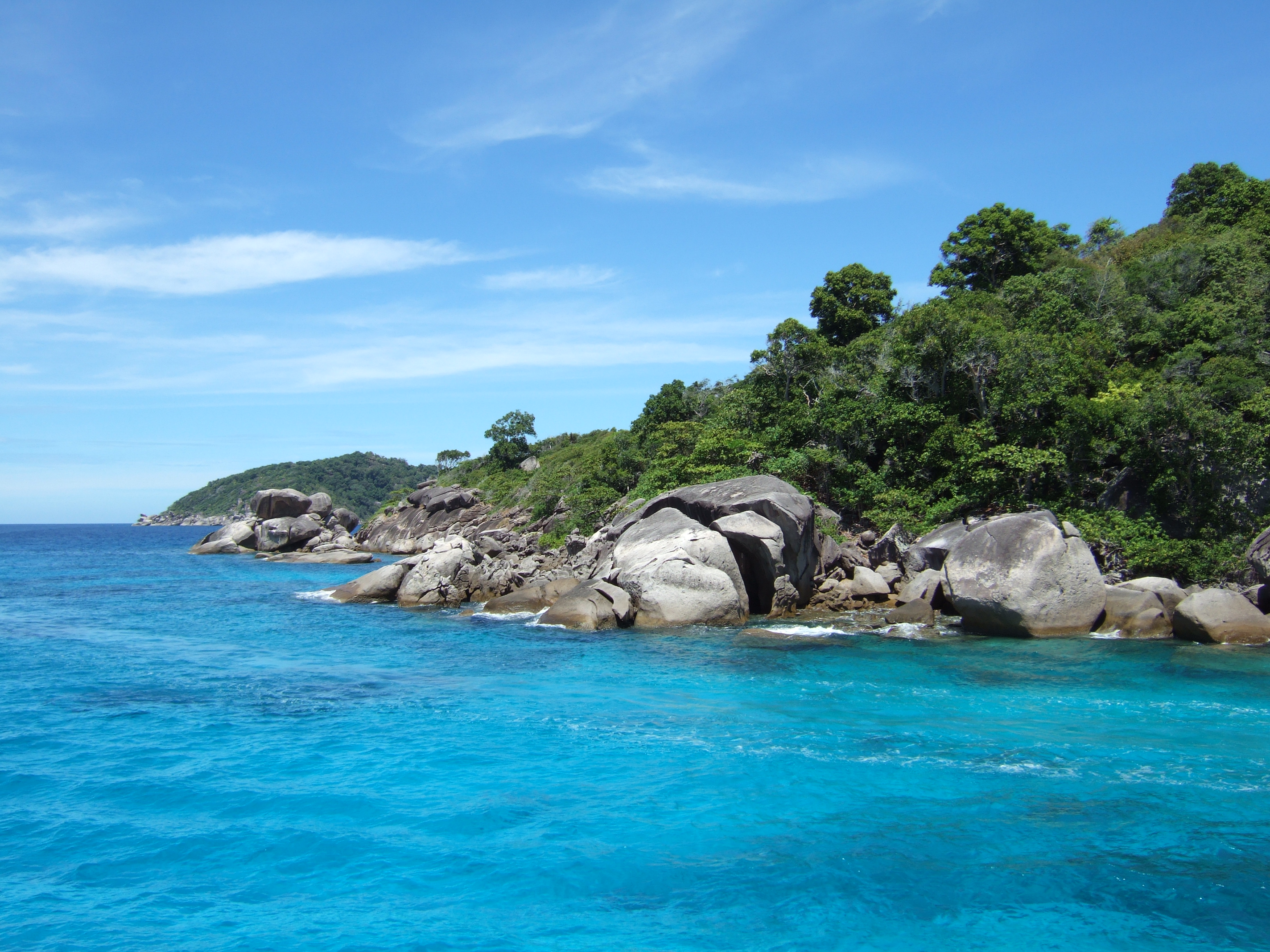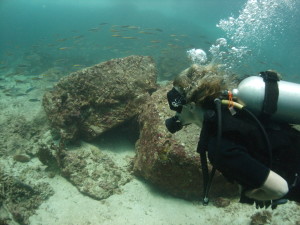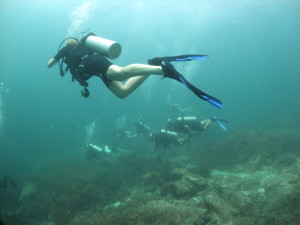News
Similan Islands Liveaboard Trip Report: Day 2

Read the prologue to this trip report here.
Read Day 1 here.
———————————————————————————————————————————————————————
After a decent night’s sleep I was up bright and early, assembling my camera after charging the batteries and re-greasing the ‘O’ rings. I took it up to the briefing deck and got some tea and toast; this would become a habit I’m afraid.
Christmas Point
 “Dive Briefing!” It was 7:30am. Today’s first dive site was going to be Christmas Point on Island number 9, the most northern point of the Similan group of Islands. It is called Christmas point due to the large amount of Christmas tree worms that can be found there. The briefing outlined that this was an exposed area, and the current can be strong – and as a result we may see some big marine life.
“Dive Briefing!” It was 7:30am. Today’s first dive site was going to be Christmas Point on Island number 9, the most northern point of the Similan group of Islands. It is called Christmas point due to the large amount of Christmas tree worms that can be found there. The briefing outlined that this was an exposed area, and the current can be strong – and as a result we may see some big marine life.
The first group once again entered the water at around 8am, followed quickly by the second and then by our group. We all descended down the mooring line to around 30 metres. Near the top of the shot line we came across a blue spotted stingray resting on the bottom. The site was made up of huge boulders and rocky outcrops, once again making it good for quite a few nice little swimthroughs and several large gullies with loads of sea fans. Twenty five plus metre visibility and a bright sun made it an incredibly blue site.
During a swim through of one of the gullies we came across a lovely blue and yellow ribbon eel, mouth open wide as it hoped to catch some breakfast. There were more fish in the shallower areas – oriental sweetlips, parrotfish, triggerfish and of course loads of Christmas tree worms. After everyone else had returned to the boat, Sharky and I carried on finding more swimthroughs. The last one looked like it might be a bit tight, but you never know until you try. Not being the smallest of people, Sharky thought he might be pulling me out by my heels, but it was a perfect fit, very little in it. The landscape underwater was very impressive. Dive five over, so time for breakfast, which once again was another pile of bacon, sausage, eggs, ham and toast.
Koh Bon
We were now heading further North to the next dive site, Koh Bon. Although not part of the Similan Islands, it is still part of the Mu Koh Similan National Park.
“Dive Briefing!” It was 10:30am. Dive six was going to be Koh Bon Ridge, on the western side of the island. Again an exposed area that can have very strong currents, which again might attract some large fish. The limestone ridge ran from the surface down to around forty metres. We were going to jump in on the east side of the ridge and swim around and over it, and if the current wasn’t too strong we would wait around looking into the blue for anything big passing by.
At around 11:00am we entered the water, descended to around 20 metres through a huge shoal of big eye snapper and headed to the ridge. There was quite a coverage of star corals (as well as the odd staghorn coral) and the usual reef fish. As we arrived at the ridge, the current greeted us; quite a good bit of current actually – we were hanging on for dear life! We hung on to the rocks for a few minutes looking into the blue for anything else that might like some strong current, but we saw nothing, so we swam over the ridge and down the other side. A couple of large Blue ring angelfish darted off as we got close (they don’t like having their picture taken). As we made our way a little shallower we came across huge beds of staghorn coral, some of which had been damaged by dynamite fishing before they made it part of the national park, but it is all beginning to grow back slowly. The staghorn corals were covered in shoals of glassfish and damsels; the odd rocky outcrop had an occasional nudibranch. As we were doing our safety stop a couple of huge barracuda swam over the ridge; at least we saw something big. 56 minutes later it was time to come up.
Koh Tachai
 Another huge lunch was awaiting us; were they trying to fatten us up? I tried to do what I could to help clear all the food, then after a few minutes on the sun deck where we said goodbye to Koh Bon, we started making our way to Koh Tachai.
Another huge lunch was awaiting us; were they trying to fatten us up? I tried to do what I could to help clear all the food, then after a few minutes on the sun deck where we said goodbye to Koh Bon, we started making our way to Koh Tachai.
“Dive Briefing!” Dive number seven was to be Koh Tachai Pinnacle at 2:30pm, a circular plateau surrounded by boulders. We were told that we might be met with some very strong currents at this site. The plan was to get straight on to the mooring line, follow it down and get into the shelter of the boulders. We would then follow the boulders around, hopefully avoiding as much current as possible before ascending back on the shot line.
We jumped in and made straight for the mooring line, and yes, there was a current. Descending to around 27 metres there was a lot of life: parrotfish, fusilier, grouper, snapper, lionfish, triggerfish, angelfish and several batfish – everywhere you looked there were fish. Shoals of wide lined fusilier swarmed all over the place; batfish accumulated near the bottom of the shot line where they were being groomed by cleaner wrasse. Time was up – another dive over.
Koh Tachai pinnacle again
“Dive Briefing!” 5:00pm. Dive number eight was going to be a dusk dive on Koh Tachai pinnacle again. The briefing was short and similar to the last, except we were told that we wouldn’t be going as deep this time. I do like dusk dives – you can see where you are going and when you take a photograph the ambient light is minimal.
We entered the water at 5:30pm. Unfortunately there was another boat on the way – they obviously had the same idea. We dropped down the line and hid from the current, which didn’t seem to be as strong as before. The dive was very similar to before; lionfish, a giant moray, scorpion fish, puffer fish, spotted boxfish were all present. The divers from the other boat entered as we were swimming around, and when we came across them I realised that it was a Japanese group. Now I have nothing against Japanese divers, but every time I meet a group of them, they seem to be a little… how should I say it? Ragged. Now I am sure that there are thousands of perfectly good divers in Japan – I just don’t think that they go to the Similans.
While we were on the mooring line the current increased. To start with, everyone’s bubbles went vertically; after a few minutes they went at the same angle as the mooring line. Thanks to the fifteen divers from our boat, plus the Japanese who were now on the line, we had a free spa bath.
Time for the evening meal. I could feel the pounds piling on; what happened to my willpower? The boat was now making for our most northerly dive site: my favourite, Richelieu Rock. We reviewed the day, solved the world’s problems, wondered why we ever would want to dive in cold water again and watched a film.
Then it was time to turn in; we were going to be up early again tomorrow.
Read Similan Islands Liveaboard Trip Report: Day 3 here.
Blogs
Northern Red Sea Reefs and Wrecks Trip Report, Part 2: Wall to Wall Wrecks

Jake Davies boards Ghazala Explorer for an unforgettable Red Sea diving experience…
The second day’s diving was a day full of wreck diving at Abu Nuhas, which included the Chrisoula K, Carnatic, and Ghiannis D. The first dive of the day was onto the Chrisoula K, also known as the wreck of tiles. The 98m vessel remains largely intact where she was loaded with tiles which can be seen throughout the hold. The stern sits at 26m and the bow just below the surface. One of the highlights of the wreck is heading inside and seeing the workroom where the machinery used for cutting the tiles are perfectly intact. The bow provided some relaxing scenery as the bright sunlight highlighted the colours of the soft coral reef and the many reef fish.

Following breakfast, we then headed to the next wreck, which was the Carnatic. The Carnatic is an 89.9m sail steamer vessel that was built in Britain back in 1862. She ran aground on the reef back in 1869 and remains at 27m. At the time, she was carrying a range of items, including 40,000 sterling in gold. An impressive wreck where much of the superstructure remains, and the two large masts lay on the seafloor. The wooden ribs of the hull provide structures for lots of soft corals, and into the stern section, the light beams through, bouncing off the large shoals of glass fish that can be found using the structure as shelter from the larger predators that are found outside of the wreck.

The final wreck at Abu Nuhas was the Ghiannis D, originally called ‘Shoyo Maru,’ which was 99.5m long and built in Japan back in 1969 before becoming a Greek-registered cargo ship in 1980. The ship then ran aground on the reef on April 19th, 1983, and now sits at the bottom at a depth of 27m. Heading down the line, the stern of the ship remains in good condition compared to the rest of the hull. The highlight of the wreck, though, is heading into the stern section and down the flights of stairs to enter the engine room, which remains in good condition and is definitely worth exploring. After exploring the interior section of the ship, we then headed over to see the rest of the superstructure, where it’s particularly interesting to see the large table corals that have grown at the bow relatively quickly considering the date the ship sank. After surfacing and enjoying some afternoon snacks, we made sure everything was strapped down and secured as we would be heading north and crossing the Gulf of Suez, where the winds were still creating plenty of chop.

The next morning, it was a short hop to Ras Mohammed Nature Reserve for the next couple of days of diving. The 6am wake-up call came along with the briefing for the first site we would be diving, which was Shark & Yolanda. The low current conditions allowed us to start the dive at Anemone City, where we would drift along the steep, coral-filled wall. These dives involved drifts, as mooring in Ras Mohammed wasn’t allowed to protect the reefs. As a dive site, Shark & Yolanda is well-known and historically had a lot of sharks, but unfortunately not so many in recent years, especially not so early in the season. However, there was always a chance when looking out into the blue.

The gentle drift took us along the steep walls of the site, with plenty of anemone fish to be seen and a huge variety of corals. It wasn’t long into the dive before we were accompanied by a hawksbill turtle, who drifted with us between the two atolls before parting ways. Between the two reefs, the shallow patch with parts of coral heads surrounded by sand provided the chance to see a few blue-spotted stingrays that were mainly resting underneath the corals and are always a pleasure to see. With this being the morning dive, the early sunlight lit up the walls, providing tranquil moments. Looking out into the blue, there was very little to be seen, but a small shoal of batfish shimmering underneath the sunlight was a moment to capture as we watched them swim by as they watched us.

Towards the end of the dive, we stopped at the wreck of the Jolanda where the seafloor was scattered with toilets from the containers it was carrying. This provided a unique site to make a safety stop, which was also accompanied by a large barracuda slowly swimming by, along with a hawksbill turtle calmly swimming over the reef as the sun rays danced in the distance.
For the next dive, we headed north to the Strait of Tiran to explore the reefs situated between Tiran Island and Sharm El Sheik, which were named after the British divers who had found them. We started on Jackson before heading to Gordons Reef, where we also did the night dive. All the atolls at these sites provided stunning, bustling coral reefs close to the surface and steep walls to swim along, which always provided the opportunity to keep an eye out for some of the larger species that can be seen in the blue. Midwater around Jackson Reef was filled with red-toothed triggerfish and shoals of banner fish, which at times were so dense that you couldn’t see into the blue. Moments went by peacefully as we enjoyed the slow drift above the reef, watching these shoals swim around under the mid-afternoon sun.

The night dive at Gordon’s Reef was mainly among the stacks of corals surrounded by sand, which was great to explore under the darkness. After some time circling the corals, we came across what we were really hoping to find, and that was an octopus hunting on the reef. We spent the majority of the dive just watching it crawl among the reef, blending into its changing surroundings through changes in colour and skin texture. It’s always so fascinating and captivating to watch these incredibly intelligent animals, in awe of their ability to carry out these physical changes to perfectly blend into the reef. Before we knew it, it was time to head back to the boat to enjoy a well-deserved tasty dinner prepared by the talented chefs onboard.
Check in for the 3rd and final part of this series from Jake tomorrow!
To find out more about the Northern Red Sea reef and wrecks itineraries aboard Ghazala Explorer, or to book, contact Scuba Travel now:
Email: dive@scubatravel.com
Tel: +44 (0)1483 411590
Photos: Jake Davies / Avalon.Red
Marine Life & Conservation
Double Bubble for Basking Sharks

 The Shark Trust is excited to announce that, for two more days only, all donations, large or small, will be doubled in the Big Give Green Match Fund!
The Shark Trust is excited to announce that, for two more days only, all donations, large or small, will be doubled in the Big Give Green Match Fund!
Donate to Basking in Nature: Sighting Giants
The Shark Trust is hoping to raise £10k which will be doubled to £20k. This will go towards Basking in Nature: Sighting Giants. And they need YOUR help to reach they’re goal.
The Shark Trust’s citizen science project is to monitor and assess basking sharks through sightings; encouraging data collection, community engagement, and promoting nature accessibility. This initiative aims to enhance health and wellbeing by fostering a deeper connection with British Sharks.
Campaign Aims
- Increase citizen science reporting of Basking Sharks and other shark sightings to help inform shark and ray conservation.
- Provide educational talks about the diverse range of sharks and rays in British waters and accessible identification guides!
- Create engaging and fun information panels on how to ID the amazing sharks and rays we have on our doorstep! These can be used on coastal paths around the Southwest. With activities and information on how you can make a difference for sharks and rays!
- Promote mental wellbeing through increasing time in nature and discovering the wonders beneath the waves!
Donate, and double your impact. Click Here
-

 News3 months ago
News3 months agoHone your underwater photography skills with Alphamarine Photography at Red Sea Diving Safari in March
-

 News3 months ago
News3 months agoCapturing Critters in Lembeh Underwater Photography Workshop 2024: Event Roundup
-

 Marine Life & Conservation Blogs2 months ago
Marine Life & Conservation Blogs2 months agoCreature Feature: Swell Sharks
-

 Blogs2 months ago
Blogs2 months agoMurex Resorts: Passport to Paradise!
-

 Blogs2 months ago
Blogs2 months agoDiver Discovering Whale Skeletons Beneath Ice Judged World’s Best Underwater Photograph
-

 Gear Reviews2 months ago
Gear Reviews2 months agoGear Review: Oceanic+ Dive Housing for iPhone
-

 Marine Life & Conservation2 months ago
Marine Life & Conservation2 months agoSave the Manatee Club launches brand new webcams at Silver Springs State Park, Florida
-

 News3 months ago
News3 months agoWorld’s Best Underwater Photographers Unveil Breathtaking Images at World Shootout 2023

















